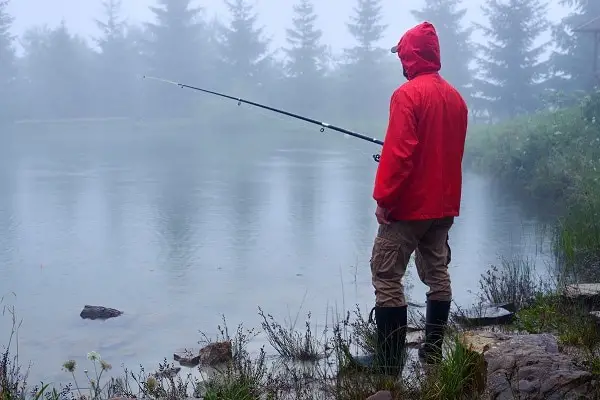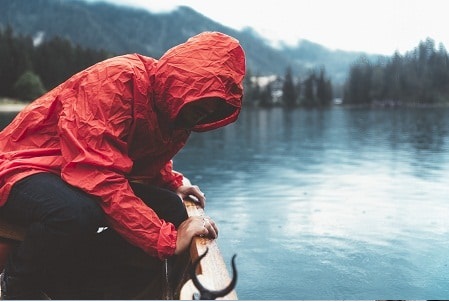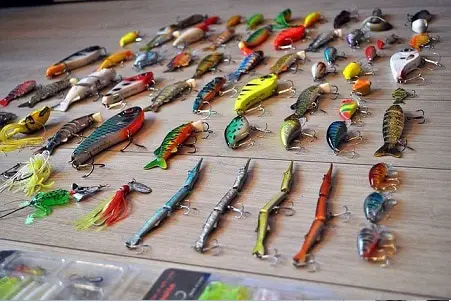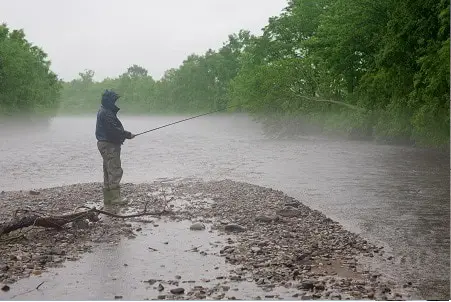Latest Articles
9 Pro Tips & Tricks To Master Fishing in the Rain
by Ben Team for Outdoor Empire, October 01, 2018
Anglers enjoy a pretty neat luxury, which few other outdoor enthusiasts can: Rainy weather won’t necessarily ruin your day. In fact, rain can often improve your chances of catching fish, in a number of different ways.
The next time you notice dark clouds rolling in, grab your fishing gear and head out to your favorite fishing spot ( and take your kids with you ). If you employ the nine tips and tricks explained below, you’ll likely have a great day on the water and become an instant advocate for fishing in the rain.
1. Invest in high-quality raingear.
man choosing raincoatKeep yourself dry and warm, and you’ll enjoy a much better time on the water (and because state-of-mind is an important factor in angling success, it’ll also help you catch more fish). This essentially means investing in some good raingear that’ll protect you from the water in even the heaviest of rains.
Skip the dollar-store ponchos and “emergency” rain suits. They may be better than nothing, but they’ll leave you soaked once you start moving around and focusing on the fish. Instead, outfit yourself with a button-up or slip on rain jacket and a matching set of rain pants. You’ll also want a good pair of waterproof boots or boot covers to keep your feet dry.
2. Look for the clearest water available.
raindrops on waterAs rainwater flows across the land, it picks up sediment and dumps it into the lake you’re fishing. This can quickly turn a normally clear lake into one that looks like it’s been filled with chocolate milk. This will make fishing exceptionally tough, so you’ll want to look for the clearest water available.
If the lake you’re fishing is large, and it hasn’t been raining for very long, you should be able to find clear water by moving away from the primary feeder streams. On the other hand, you’ll want to seek out sheltered coves or similar, protected locations if it has been raining for an extended period of time.
3. Be sure to try your topwater lures.
topwater lureMany anglers love to fish with topwater lures — they are, after all, a blast to use. But the problem is they don’t work in all situations. They’re typically best reserved for the early morning, late afternoon or throughout moon-lit nights ( learn more about best time day to fish ). However, they can also be deadly when it’s raining, when bass often approach the surface and feed aggressively.
You can use your topwater lure of choice, but you’ll likely have the best results by using lures that create a fair bit of commotion on the surface. Pick out one that makes a lot of noise and splash and opt for a slightly larger size than you normally would.
4. Follow the wind to find the fish.
It can often be difficult to find the fish when it is raining, as it disrupts their normal patterns, causing them to stage in places you may not often suspect. However, if you find the baitfish, you’ll almost always find bass close on their heels. And, because small fish tend to get blown around quite a bit, you can often find them at the downwind side of the lake.
However, many baitfish will also use current and windbreaks as resting spots, so it also makes sense to target areas that may allow baitfish to escape the forces of nature and take a breather. This can mean coves, the down-wind side of points or around docks and other man-made objects.
5. Get a bit closer when possible.
If you like to pitch or flip for bass holding in tight cover, you probably already know that you need to stay back far enough to avoid spooking the fish. But when it’s raining, the fish won’t be able to see you as well, which means you can usually creep a little closer to the areas you are targeting.
This will not only help improve your casting accuracy and make hooksets easier, but it will also let you reduce the amount of splash you make when the lure hits the water.
6. Try to identify the most effective pattern quickly.
angler casting in waterRainy weather often causes fish to change up their typical routine. They may stage in different places than they normally would, move up or down in the water column, or they may begin looking for different types of prey. This all means that you’ll have to try a number of different lures and presentations to figure out the winning pattern.
However, you’ll often need to do so quickly; if the weather changes, the bass will likely begin changing their behavior too.
7. Experiment with new presentations and lures.
lure setFishing in the rain often requires a good bit of experimentation, as the lures and techniques that are typically effective on a given lake or river may fail to produce results once it begins raining. Sometimes, you can find a winning combination by simply making minor tweaks, such as changing your lure color, but you’ll need to be more creative at other times.
In such cases, you may want to throw out the rulebook entirely. If the conditions and time of year would normally call for a deep crankbait fished quickly, try to “helicopter” a spinnerbait or slow-roll one along the bottom. If you haven’t yet figured out the most effective pattern for the current conditions, you don’t have much to lose by experimenting.
8. Consider the water temperature when searching for fish.
hand dipped in waterRain can alter the temperature of the water pretty significantly. If, for example, a cold front moves through during the late spring or summer, it can quickly drop the water temperature, which may encourage fish to feed. Conversely, a warm rain will help elevate the temperature of the water, which may be advantageous during the cool portions of the year.
Note that precipitation won’t change the temperatures in deeper water very much. So, if the rain is causing the temperature to change in the opposite direction you’d like (such as a cold front blowing through in the early spring), you may be able to find fish hanging out deeper, in water that provides more comfortable temperatures.
9. Cast around feeder creeks and runoff areas.
fishing by the creekCreeks and other areas that drain into lakes often bring with them an abundance of insects and feeder fish. This can make these areas very productive, as bass and other gamefish often hang out in these areas, in an effort to ambush prey.
However, it is important to note that these areas will also carry a lot of sediment with them, which can make the water cloudy and make fishing more difficult. Accordingly, it is usually wise to hit feeder creeks shortly after the rain starts. Once it has been raining for a while, you’ll likely want to move on in search of clearer water.
***
Hopefully, we’ve not only convinced you to try fishing in the rain but given you a few tips and tricks that should prove helpful too.
Just remember to keep safety in mind and be reasonable when trying to fish through the rain. Don’t head out on the water when lightning, high winds or dangerous water conditions threaten. It’s always better to be safe than sorry, so err on the side of caution if you don’t feel like the conditions will allow you to fish safely.
Re-published with permission Outdoor Empire
Ben Team writes about outdoor recreation, natural sciences and environmental issues. Read more by Ben at www.FootstepsInTheForest.com.



